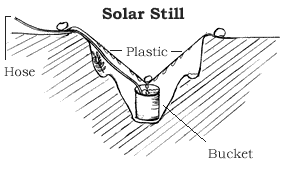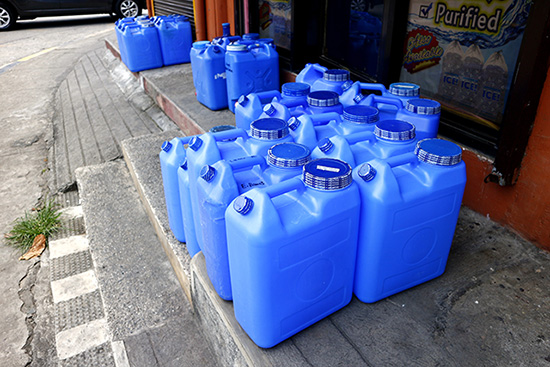Water is more essential than food in sustaining life, and over the long term needs to be constantly available from an unpolluted source. But realistically, in case of severe emergency, plan to have enough water to sustain your family for TWO WEEKS.
How Much to Store:
Water storage should take top priority in emergency preparedness. 1 gallon per day per person is the recommended minimum. 1/2 gallon (2 quarts) for daily drinking and ½ gallon for daily washing. Try going without the water from your faucets one day and see how you fare with your emergency water supply. You may decide, like we did, to dejunk more storage areas and make room for more water!
Store a minimum of 7 gallons of water per person for drinking and food preparation. Store an additional seven gallons per person of the same quality water for bathing, brushing teeth, and dishwashing. This is approximately 3 gallons per person for 72 hours, or 14 gallons for 2 weeks.
How to Store:
Water can be stored in any durable non-glass container designed to store liquids for extended periods. If you use plastic, plan on changing the water every few months, as there is some transfer of toxic materials from some plastics to the water. Empty plastic milk jugs are food-grade, but they may start leaking over a period of time. Empty and cleaned 2-liter pop bottles hold up just fine with indoor storage where the temperature is more constant; however, a 2-liter bottle that has been in the car-trunk during the heat of the summer and extreme cold of winter will eventually start to crack. Put a new 2-liter bottle of water in your car trunk at the change of extreme hot and extreme cold weather.
In summary, use heavy plastic containers with tight fitting lids. Metal containers, which may corrode, tend to give water an unpleasant taste. If possible, use non-breakable containers for your water storage. You could end up without a water supply if all your glass containers are shattered.
Water Treatment:
8 drops of chlorine bleach per gallon of water can be added If the tap water you are storing is not already chlorinated from the public water supply. If the tap water you use is already chlorinated, just put that water directly into you clean, food-grad container with out adding extra chlorine bleach. USU research indicates that the water should last for at least 10 years. However, if you store the water in a glass container that has a cardboard liner in the lid, the cardboard will disintegrate and create off flavors and off odors. So, if you have such a water-storage container, take the cardboard liner out before you store water.
If you have any doubt as to the bacterial safety of stored water, you may purify it by boiling vigorously for 1-2 minutes, or as mentioned, by adding chlorine bleach. Generally, ½ a teaspoon of bleach will purify 5 gallons of clear water, and 1 teaspoon will purify 5 gallons of cloudy water. If you store it away from sunlight in clean containers, and if it is safe bacterially at the time of storage, water will remain pure indefinitely.
To be safe for culinary use, water must be rendered chemically and biologically harmless. The right water purifier would remove harmful bacteria, protozoa, amoebae, viruses, fibers, sediment (microscopic particles of dirt, rust, scale, radioactive particles etc.), organics, and other agents such as chlorine and radioactive gasses. The best type use ceramic cartridges, sup glass and/or carbon for filtering with silver, iodine or chlorine to kill bacteria. Some are more effective than others. Systems using iodine probable give the most complete bacteriological protection. Even those using essentially only mechanical filters with a small pore size are very effective. In the event of nuclear war, when fallout is a problem, the dissolved and undissolved radiation particles should be removed from the water to the greatest extent possible before other purification measures are taken. Activated carbon contained in many of the purification devices will remove moist of these contaminates. Contact Alan South for the ideal water-purifiers 1-877-767-4382
Note:
If a disaster disrupts the electricity needed to pump the water to your home, there should be a sufficient amount for drinking and food preparation stored within the pipes in the house to last for a short period , if used sparingly. Water can be drawn from the lowest faucet in the house (usually the water heater or water tank) if the highest facet is opened a bit to let air into the pipes.
Remember that canned fruit and fruit juices also have a high content, and their liquid can count as part of your water supply. Individual cartons of fruit or fruit juice are great for a 72-hour kit.
A carrying strap that is attached to the top of your own 1-liter or 2-liter of water can also be useful. If you don’t have one from an emergency preparedness store, a heavy string or strip of fabric could easily be substituted.

Other Sources of Water:
Lakes, ponds, ditches, and streams all have water, but it should be rendered safe before being used. Springs, seeps, appropriately-located cisterns, and wells can also be good sources of water. Even a small solar still could provide some drinking water until other sources could be developed. See Sense of Survival for diagrams and instructions on making water filters, a well, improvised well pump and finding water in the desert.



0 Comments
Adhering to pallet rack safety rules prevents mishaps in any storage environment. Start by verifying that all racks are properly anchored.
Load capacities should never be exceeded. Overloading or uneven loads can weaken the structure and cause issues.
Examine your racks regularly for visible issues. Replace or repair damaged components as soon as possible.
By complying with these guidelines, you maintain a safer warehouse environment.
Used Pallet Racking for sale
Self-Performed Warehouse Rack Fixes: What You Need to Know 8_2af77